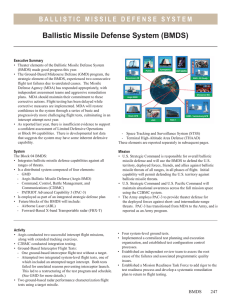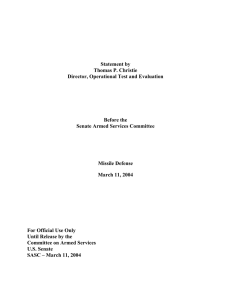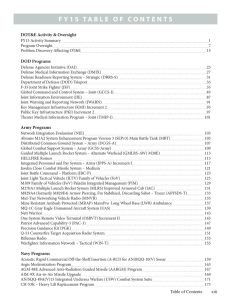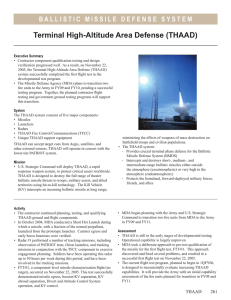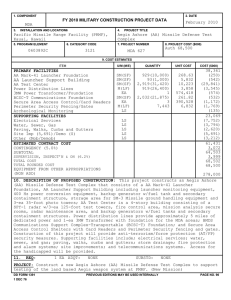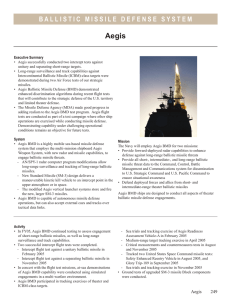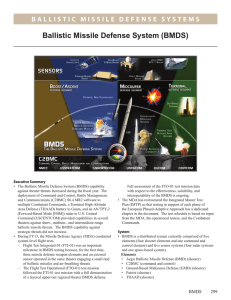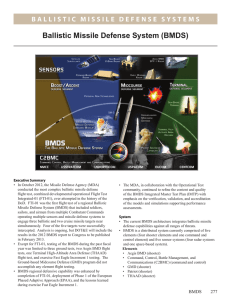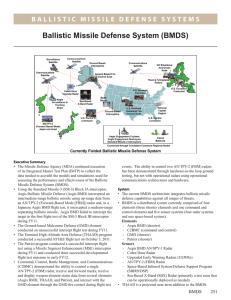Overview B A L L I S T I C ...
advertisement
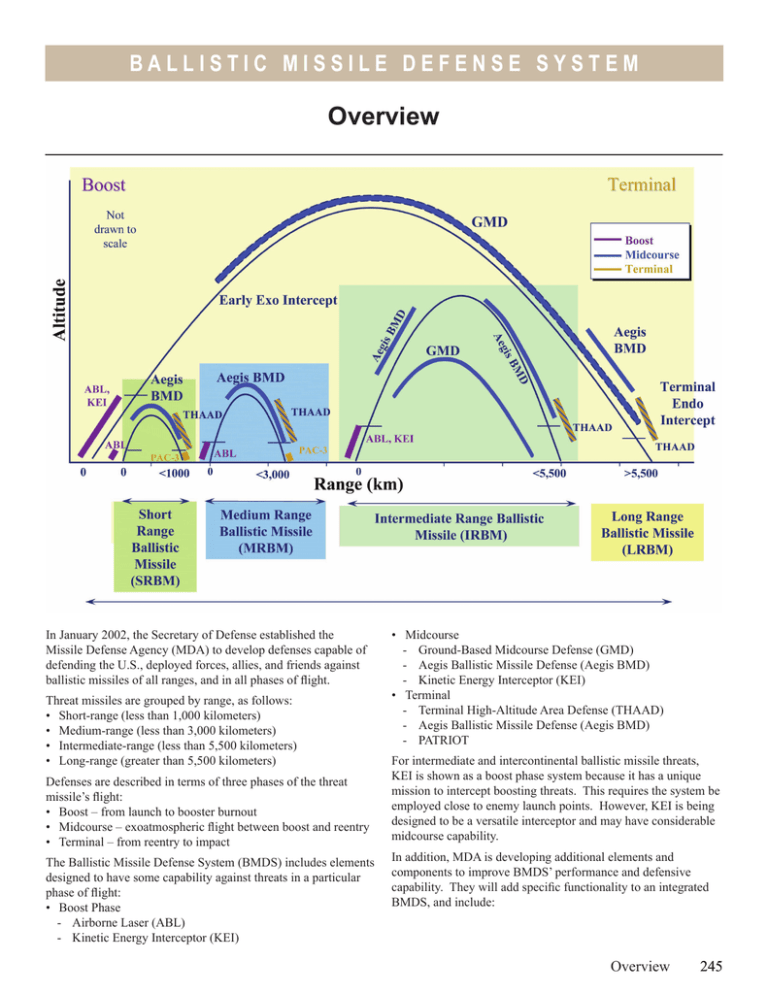
BALLISTIC MISSILE DEFENSE SYSTEM Overview In January 2002, the Secretary of Defense established the Missile Defense Agency (MDA) to develop defenses capable of defending the U.S., deployed forces, allies, and friends against ballistic missiles of all ranges, and in all phases of flight. Threat missiles are grouped by range, as follows: • Short-range (less than 1,000 kilometers) • Medium-range (less than 3,000 kilometers) • Intermediate-range (less than 5,500 kilometers) • Long-range (greater than 5,500 kilometers) Defenses are described in terms of three phases of the threat missile’s flight: • Boost – from launch to booster burnout • Midcourse – exoatmospheric flight between boost and reentry • Terminal – from reentry to impact The Ballistic Missile Defense System (BMDS) includes elements designed to have some capability against threats in a particular phase of flight: • Boost Phase - Airborne Laser (ABL) - Kinetic Energy Interceptor (KEI) • Midcourse - Ground-Based Midcourse Defense (GMD) - Aegis Ballistic Missile Defense (Aegis BMD) - Kinetic Energy Interceptor (KEI) • Terminal - Terminal High-Altitude Area Defense (THAAD) - Aegis Ballistic Missile Defense (Aegis BMD) - PATRIOT For intermediate and intercontinental ballistic missile threats, KEI is shown as a boost phase system because it has a unique mission to intercept boosting threats. This requires the system be employed close to enemy launch points. However, KEI is being designed to be a versatile interceptor and may have considerable midcourse capability. In addition, MDA is developing additional elements and components to improve BMDS’ performance and defensive capability. They will add specific functionality to an integrated BMDS, and include: Overview 245 BALLISTIC MISSILE DEFENSE SYSTEM • Forward-Based X-band Transportable radar (FBX-T) • Command, Control, Battle Management, and Communications system (C2BMC) • Multiple Kill Vehicle program (MKV) • Space Tracking and Surveillance System (STSS) MDA describes development objectives for each two-year Acquisition Block using Engagement Sequence Groups (ESGs). ESGs correspond to a series of tasks that must be accomplished during a defensive mission. The concept of an ESG can be TRL Description 1 Basic principles observed 2 Technology/application concepts 3 Demonstration of critical functions/proof of concept 4 Component validation in laboratory 5 Component validation in relevant environment ESG Level 7 System/subsystem model or prototype demonstrated in relevant environment System prototype demonstration in a space environment 8 Actual system completed and “flight qualified” through test and demonstration (ground or space) 6 9 Transition Actual system “flight proven” through successful mission operations System or component transitions to a Service for procurement and fielding as an acquisition program or for operations and sustainment The joint Operational Test Agency team has used the criteria in the Joint Chiefs’ of Staff (JCS) Publication “Aerospace Defense of North America,” JCS Publication 3-01.1, to assess performance. The JCS basic defense criteria are to detect, classify, track, intercept, and destroy a threat missile. Implicit in these steps is the ability to pass and process information necessary to control the engagement. Future capability assessments will more closely support user requirements, and focus on defending prescribed geographic regions. The BMDS Block 04 fielded test bed architecture consists of GMD, Aegis BMD, C2BMC, and PATRIOT. The Block 04 246 applied to any set of hardware and software, regardless of its maturity. Consequently, MDA has created three levels within the ESG construct that correspond to the technological maturity of essential system components. The following table shows the relationship between ESG levels and Technology Readiness Levels (TRL). The table also shows the systems that are associated with each ESG level. Some systems, such as C2BMC, have capabilities at various levels of development and appear in multiple categories. Overview 3 Path to Operational Capability Technology Maturation C2BMC, ABL, KEI, MKV, STSS ESG Maturation 2 1 Operational Architecture GMD(GBI), Aegis, C2BMC, FBX-T, THAAD Capability Verification GMD, Aegis, C2BMC, PATRIOT Transitioned to Operations PATRIOT mission is to provide midcourse defense of U.S. territory against long-range threats from specific geographic areas, and terminal defense of deployed forces, allies, and friends against short-range threats. This report focuses on the Block 04 architecture as well as ABL, FBX-T, THAAD, and STSS elements that are still in development. PATRIOT has transitioned to the Army, and is reported as an Army program.

